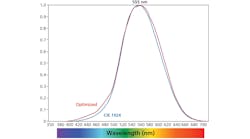August 15, 2004
The perception that Hyundai may not be at the leading edge of car design and technology adoption was dispelled somewhat when the company unveiled its HCD8 sports coupe concept at the start of 2004. With its highly distinctive design, the HCD8 utilizes LEDs for all exterior lighting functions, including head lamps and front fog lamps based on white LEDs.
Improvements required
Although the rear lights on the HCD8 could readily be transferred to a production vehicle, the same is not true for the front headlamps. "The chips themselves are not able to supply enough lumens, and it's not possible to take enough of those chips and combine their output into a beam pattern that meets government regulations," says Piaskowski. "By 2007-8, this should have been rectified, albeit at a relatively high cost, but as with any new technology those costs will come down dramatically as more supply gets into the marketplace."
For tail lamps and indicators, a major advantage of LEDs is that they turn on much more quickly than conventional lights, creating a real and perceived safety benefit. "I've sat in a number of focus groups where consumers have said that the brake lights and tail lamps on a particular vehicle look too small, and won't be clearly seen by a following vehicle," explains Piaskowski. But if a salesperson is able to explain that the car has LED brake lights, which light up much faster than conventional bulbs, this is seen as a positive safety feature.
As well as safety, LEDs add the air of new technology and can be used to create a visual difference between models, which is becoming increasingly important in the car industry. The low power consumption and long lifetime of LED lights are also important advantages.
Design advantages
Another design advantage is the freedom to vary the visual arrangement of the LEDs within the lamp housing. "This allows for a lot more creativity on the part of the designers who do the styling and the engineers who make the design work," says Piaskowski. "By using different patterns, we are able to create a more distinctive appearance - what we call 'down the road graphics'." Many manufacturers have already created distinctive rear prospects using center high-mounted stop lamps (CHMSLs) and other LED lamps, and are now starting to do the same at the front.
The LEDs used on the HCD8 were supplied by Osram Opto Semiconductors, with drivers from Supertex and optics from Light Prescriptions Innovators (LPI). The lenses, which Piaskowski describes as looking like "little acrylic disks", are the product of several years of intense development.
The chances are that Hyundai won't be the first company to adopt white LED headlights in production vehicles, but even so various Hyundai and Kia models with LED rear lamps and indicators have already been introduced in the Korean market and some overseas markets. The HCD8 demonstrates that many cars could soon adopt LEDs for all their exterior lighting requirements.







